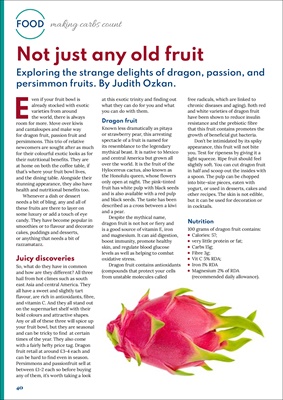
40
FOOD making carbs count
Nutrition
100 grams of dragon fruit contains:
Calories: 57;
very little protein or fat;
Carbs 15g;
Fibre 3g;
Vit C 5% RDA;
Iron 1% RDA
Magnesium 2% of RDA
(recommended daily allowance).
Not just any old fruit
Exploring the strange delights of dragon, passion, and
persimmon fruits. By Judith Ozkan.
Even if your fruit bowl is
already stocked with exotic
varieties from around
the world, there is always
room for more. Move over kiwis
and cantaloupes and make way
for dragon fruit, passion fruit and
persimmons. This trio of relative
newcomers are sought after as much
for their colourful exotic looks as for
their nutritional benefits. They are
at home on both the coffee table, if
that's where your fruit bowl lives,
and the dining table. Alongside their
stunning appearance, they also have
health and nutritional benefits too.
Whenever a dish or dessert
needs a bit of bling, any and all of
these fruits are there to layer on
some luxury or add a touch of eye
candy. They have become popular in
smoothies or to flavour and decorate
cakes, puddings and desserts,
or anything that needs a bit of
razzamatazz.
Juicy discoveries
So, what do they have in common
and how are they different? All three
hail from hot climes such as south
east Asia and central America. They
all have a sweet and slightly tart
flavour, are rich in antioxidants, fibre,
and vitamin C. And they all stand out
on the supermarket shelf with their
bold colours and attractive shapes.
Any or all of these three will spice up
your fruit bowl, but they are seasonal
and can be tricky to find at certain
times of the year. They also come
with a fairly hefty price tag. Dragon
fruit retail at around £3-4 each and
can be hard to find even in season.
Persimmons and passionfruit sell at
between £1-2 each so before buying
any of them, it's worth taking a look
free radicals, which are linked to
chronic diseases and aging). Both red
and white varieties of dragon fruit
have been shown to reduce insulin
resistance and the prebiotic fibre
that this fruit contains promotes the
growth of beneficial gut bacteria.
Don't be intimidated by its spiky
appearance, this fruit will not bite
you. Test for ripeness by giving it a
light squeeze. Ripe fruit should feel
slightly soft. You can cut dragon fruit
in half and scoop out the insides with
a spoon. The pulp can be chopped
into bite-size pieces, eaten with
yogurt, or used in desserts, cakes and
other recipes. The skin is not edible,
but it can be used for decoration or
in cocktails.
at this exotic trinity and finding out
what they can do for you and what
you can do with them.
Dragon fruit
Known less dramatically as pitaya
or strawberry pear, this arresting
spectacle of a fruit is named for
its resemblance to the legendary
mythical beast. It is native to Mexico
and central America but grown all
over the world. It is the fruit of the
Hylocereus cactus, also known as
the Honolulu queen, whose flowers
only open at night. The pink-tinted
fruit has white pulp with black seeds
and is also available with a red pulp
and black seeds. The taste has been
described as a cross between a kiwi
and a pear.
Despite the mythical name,
dragon fruit is not hot or fiery and
is a good source of vitamin E, iron
and magnesium. It can aid digestion,
boost immunity, promote healthy
skin, and regulate blood glucose
levels as well as helping to combat
oxidative stress.
Dragon fruit contains antioxidants
(compounds that protect your cells
from unstable molecules called